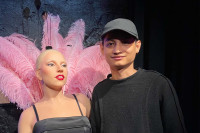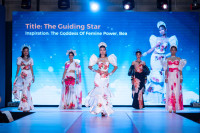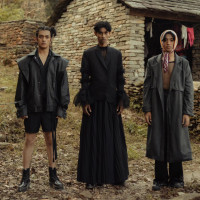Fashion
They rejected her because she is a transwoman. Now she is on top.
Anjali Lama is talented, confident, brave but most importantly, she has been breaking gender barriers in the glamour industry.
Ankit Khadgi
In September, Anjali Lama was named ‘Model of the Year’ at the Vogue Beauty Awards held in Mumbai, India. The Vogue title is a feat that takes models in the industry years to achieve, but Lama was able to bag the title in just two years. Her first show in the Indian fashion scene had taken place just two years prior, in 2017, when she walked at the Lakme Fashion Week.
In the two short years she’s been in the Indian fashion industry, she has slowly become part of every big name Indian designer’s runway. She is also the face of international fashion brands like Puma, Levis and Calvin Klein. But success didn’t come easy for this transgender model, who originally hails from Nuwakot.
“If rejections were to drag me down, I couldn’t even have asserted my true identity,” says Lama.
The struggles of the queer community in Nepal are deeply rooted, and they were brought to light only after the country underwent a massive socio-political change in 2006, in terms of individual freedom and identity. But even though the LGBTIQ community has fought for equality for years, discriminations based on identity and sexual orientations are still rife. Lama says she has had to encounter such prejudice since the time she came to terms with her identity.
She was asked to leave her family home when she came out to her parents—that was the first of many rejections she had to face. As she eventually moved to Kathmandu, she did find solace in the company of others who were going through the same struggles as her. But when she decided to enter the modelling industry in 2009, she had to fight a lonely battle.

“Many fashion event organisers used to tell me directly that they had to reject me because of my identity,” says Lama. “Even when they acknowledged that I was deserving.”
This used to be the staple response from the fashion industry, says another model Meghna Lama. “The biggest fashion shows in the country rejected us, but Anjali proved all of them wrong,” Meghna says.
While Meghna went on to open Pink Tiffany, Kathmandu’s first openly LGBTIQ-friendly restaurant and bar, while still taking sparse modelling jobs in Nepal, Lama tried realising her dreams of becoming an international model, auditioning for international fashion events.
It came with its own hurdles, for even to land a spot in the prestigious Lakme Fashion Week, one of the most sought-after fashion events in South Asia, Lama had to audition twice before she was finally selected in 2017. She was the first transgender model to walk the runway for Lakme.
“Every rejection is a lesson for me,” says Lama. “I have faced many rejections, but I have never let them affect my confidence and determination.”
Through her work, Lama has managed to break the glass ceiling for transgenders in both Nepal and India, yet equal rights for the queer community have yet to be acknowledged—both socially and politically, she says.

During a recent press meet in Hotel Akama in Dhumbarahi, Lama particularly shared her reservations over a provision in a bill registered by the Home Ministry demanding proof of gender transformation to obtain new citizenship. The vaguely worded provision, she says, can result in further discrimination against gender and sexual minorities.
“Not everyone can afford sex change operation and not everyone wants to do it,” she says. “This provision puts unnecessary mental pressure on transgender individuals who are already facing a lot of struggle and discrimination.”
Lama attributes these regressive attitudes and laws to the queer narratives being led by cis-gender individuals in policy level as well as in popular media. While the media plays an important role in shaping the mindset of society in the de-stigmatisation of gender and sexual minorities, Lama says that it is also important the media cover these issues in a responsible and sensitive manner.
“Many of the issues regarding the queer community are evolving,’ she says. “And the media needs to be aware of them.”
Like Lama, many young queer individuals have expressed their concerns over how the state has been perceiving the rights of the queer community.
On December 21, 2007, the Supreme Court of Nepal recognised transgender individuals as ‘third gender’ under the public interest litigation filed by Sunil Babu Pant, the first openly gay legislator in Nepal, against the government of Nepal. This was regarded as a landmark victory for the entire LGBTIQ community in Nepal, which also made international headlines.
But the queer community believe this provision limits individuals to certain criteria rather than acknowledging them on a spectrum. “Being put into the ‘other’ or ‘O’ category in citizenships and passports is insensitive and outdated,” says Lama. “Every individual should have the right to choose one's sexual identity on the basis of self-identification.”
This cycle of rejection that queer individuals face, Lama says, can be minimised if these kinds of provisions in the law are revised and the state takes suggestions and recommendations from the LGBTIQ community itself. But in order to amplify their voices, the community needs to band together and have more success stories, she says.
From her personal experience, she shares that people who used to avoid her during her struggling days wants to be associated with her after gaining professional success.
“Don't be scared,” advises Lama to young queer individuals. “There is nothing wrong about your identity and orientation. Self-identification is very important.”
It is definitely easier said than done. Even after being acknowledged as a supermodel and taking on the covers of big fashion magazines like Vogue India, GQ and Grazia, Lama has been constantly struggling—even for simple things in life, like finding a place to live.
But being no stranger to rejections, Lama believes in pushing forward. For now, she is looking forward to progressing her modelling career, but in the long run, she plans to open a modelling school in Nepal and advocate for queer rights.




 6.12°C Kathmandu
6.12°C Kathmandu










